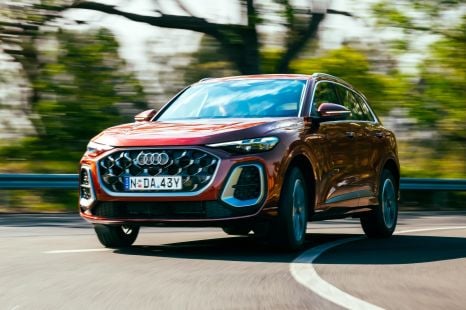

James Wong
2026 Audi Q5 review: Quick drive
5 Days Ago
It doesn't look like anything else... except the EQS. It's Mercedes Benz's new EQE electric sedan – just don't call it an electric E-Class.
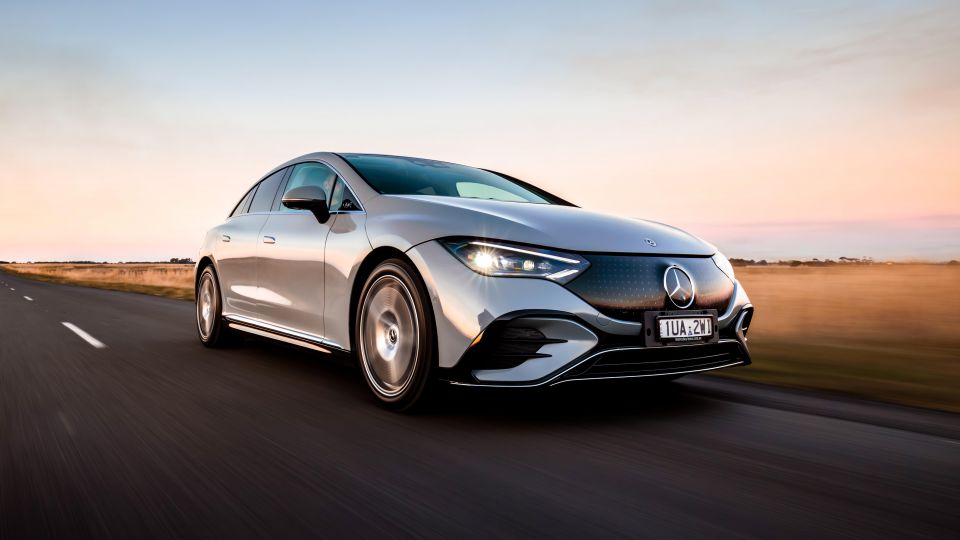
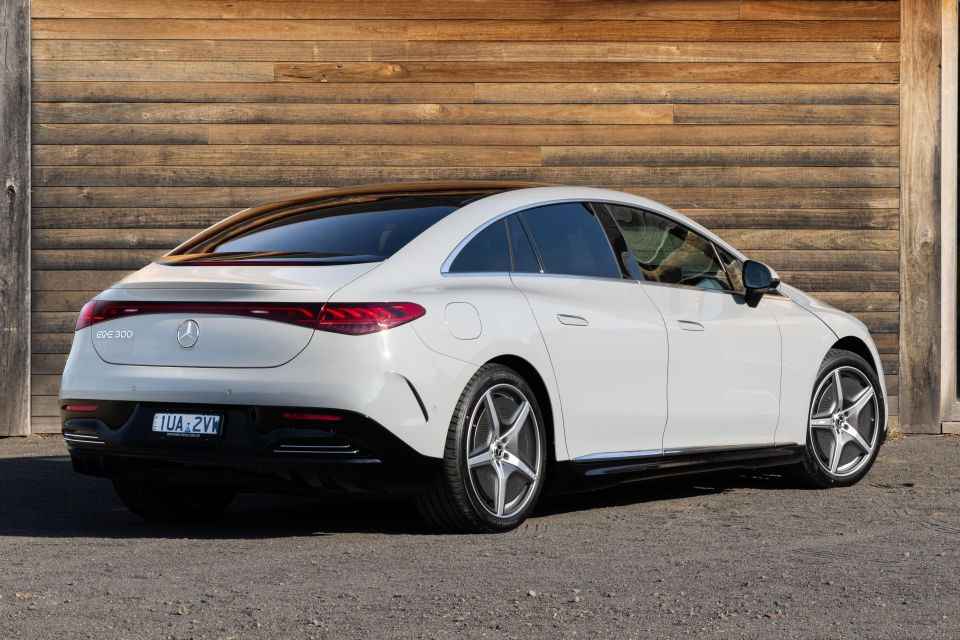

Quickly see how this car stacks up against its competition. Select any benchmark to see more details.
Where expert car reviews meet expert car buying – CarExpert gives you trusted advice, personalised service and real savings on your next new car.
It might be sized similarly to the brand’s familiar E-Class sedan, but the new Mercedes-Benz EQE couldn’t look any more different.

There’s plenty to discuss here about the brand’s first pure-electric sedan (the larger EQS is a liftback), but let’s address the elephant in the room: the styling.
If you don’t care for the looks of the flagship EQS, we suspect you won’t be a fan of the EQE sedan either.
It resembles a stumpier version of its larger liftback counterpart, and looks about as much like a wedge as anything this curvaceous can. The rakish looks aren’t just for style: the EQE boasts a slippery drag coefficient of 0.22, though the EQS has it beat at 0.20.
Unlike the smaller EQA and EQB, and the EQV van, the EQE rides a dedicated electric vehicle architecture.
Called EVA2, this also underpins the EQS as well as the upcoming EQE SUV and EQS SUV that are almost certain to outsell their lower, sleeker counterparts.
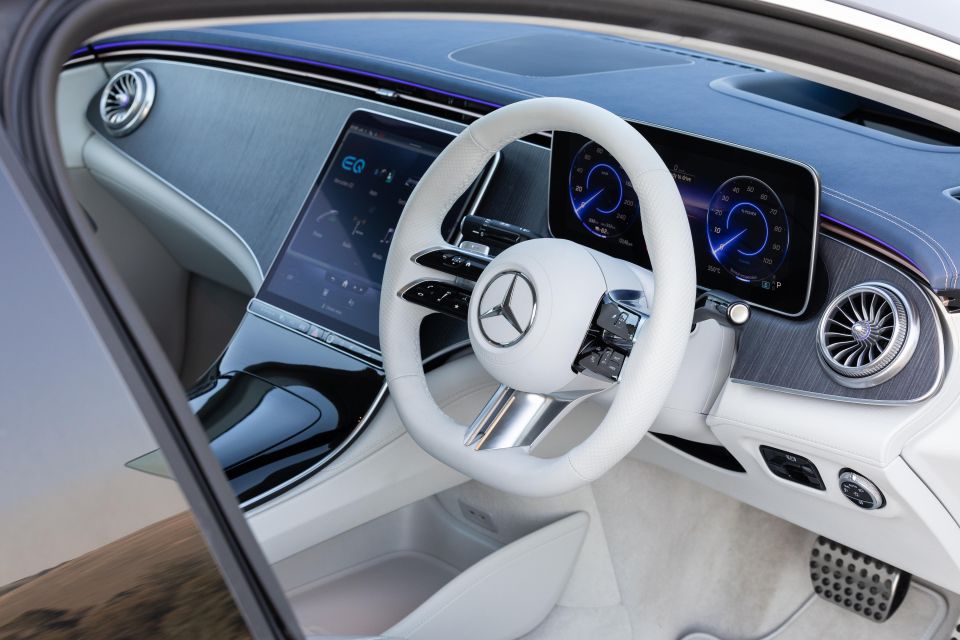
Mercedes-Benz says it expects the EQE to appeal to younger buyers than the more conservatively styled, combustion-powered E-Class, which will continue to be sold alongside it. In fact, a new-generation E-Class is due in Australia next year, making for a particularly interesting showroom comparison.
The brand’s strategy is in stark contrast with arch-nemesis BMW, wherein the combustion 5 Series and electric i5 will both share a platform and look largely the same.
Mercedes-Benz appears to think the EQE’s daring styling will endear it to a different kind of buyer.
The EQE 300 is priced from $134,900 before on-road costs, while the EQE 350 4Matic starts at $154,900 before on-roads.
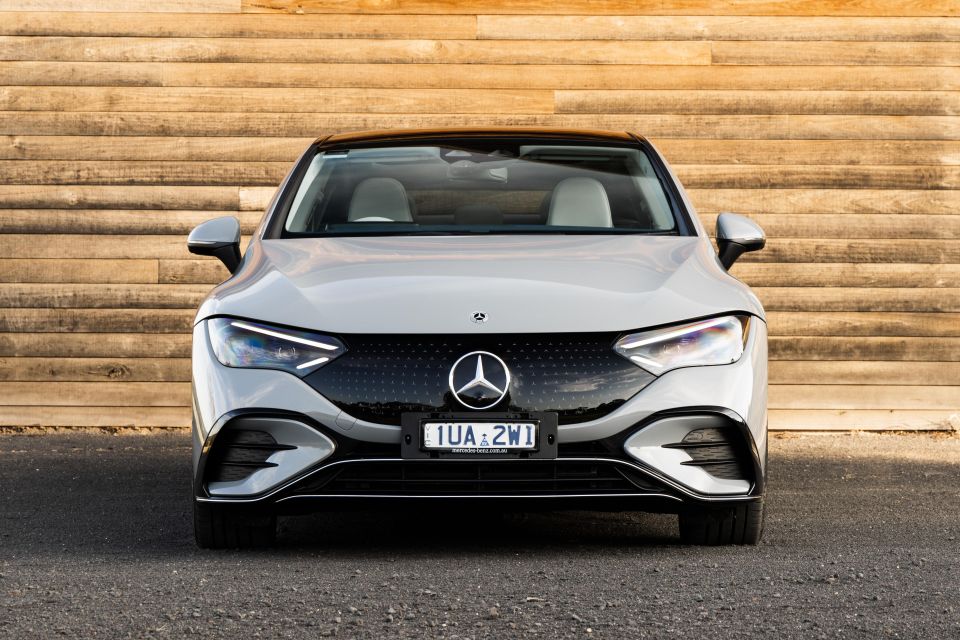
There’s also an AMG EQE 53, which we have reviewed separately, that rings up at $214,900 before on-roads.
The current W213-series E-Class is in runout following the reveal of the new W214 generation, for which local pricing has yet to be released. The outgoing model starts at just $106,600 before on-roads, though the EQE 300 has more standard kit than a base E200 – more on that later.
The EQE350 does narrowly undercut the now-defunct CLS450, which was also a sleeker counterpart to the E-Class, if one with petrol power. Mercedes-Benz says the EQE has styling “very reminiscent of the CLS”, and it indirectly replaces that model in the local line-up.
The EQE range will battle the upcoming Audi A6 e-tron and BMW i5, as well as the Tesla Model S that’s currently off-sale in Australia. It’s been narrowly beaten to market by the dual-motor all-wheel drive Genesis Electrified G80, priced at $145,000 before on-road costs. There’s also the Porsche Taycan, which opens at $165,700 before on-roads in rear-wheel drive guise.
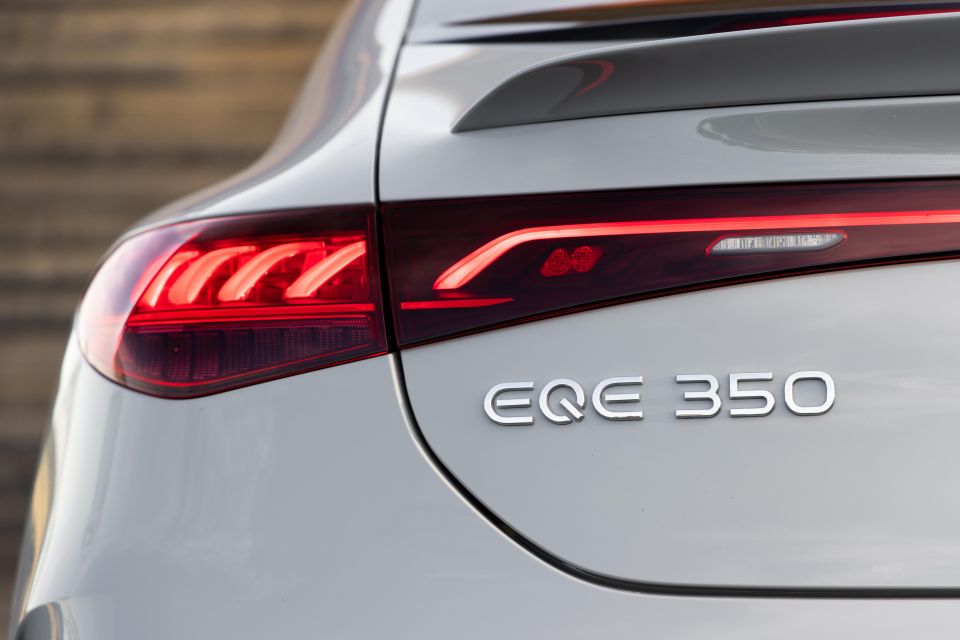
2023 Mercedes-Benz EQE pricing:
Prices exclude on-road costs
Buy your new car without the stress. It's fast, simple and completely free.

Great service from Travis and team, second time I have used this business would not hesitate to recommend them to anyone
Craig C.
Purchased a Ford Ranger in Sunshine Coast, QLD
CarExpert helped Craig save $7,224 on his Ford Ranger, now let us save you on your next new car.
Get your BEST priceThe EQE’s name may suggest it’s an electric counterpart to the E-Class, but it simply doesn’t offer the same type of accommodation in the back of its cabin as the vehicle so popular in Germany as a taxi.
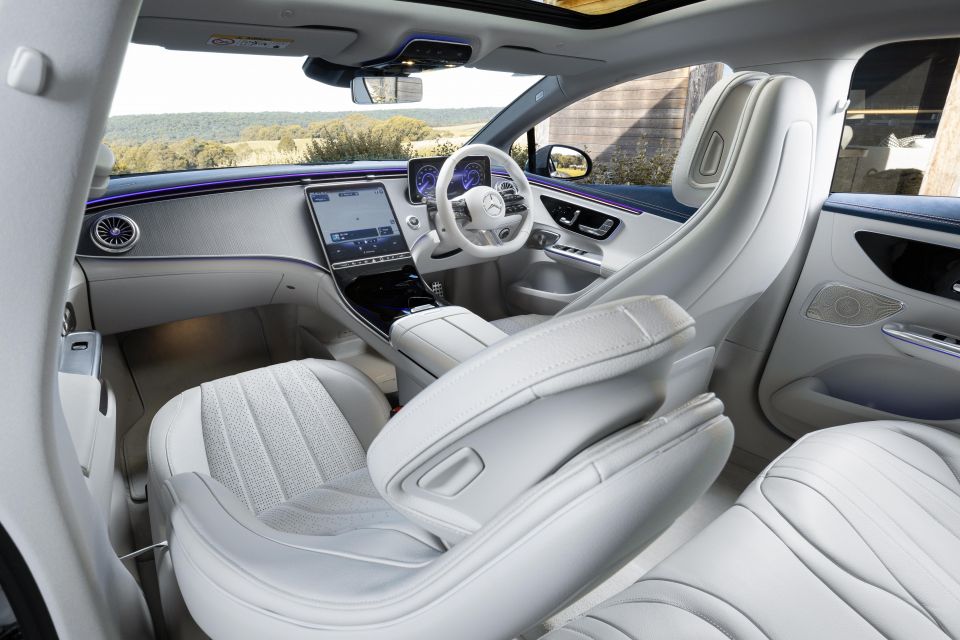
That’s despite it measuring 23mm longer and 54mm wider on a 181mm longer wheelbase than the E-Class.
The placement of the battery and the typically long wheelbases of electric vehicles often lead to superior interior packaging of combustion vehicles.
However, in the push for maximum efficiency, Mercedes-Benz designers have prioritised aerodynamic performance. Not only has that led to unusual exterior styling, it has also eaten into interior space.
All EQE models in Australia come with a panoramic glass roof, and while I at 180cm could sit without touching the glass roof in the middle seat, someone my height or taller will find the side of their head brushing the roof. Toe room is also somewhat lacking.
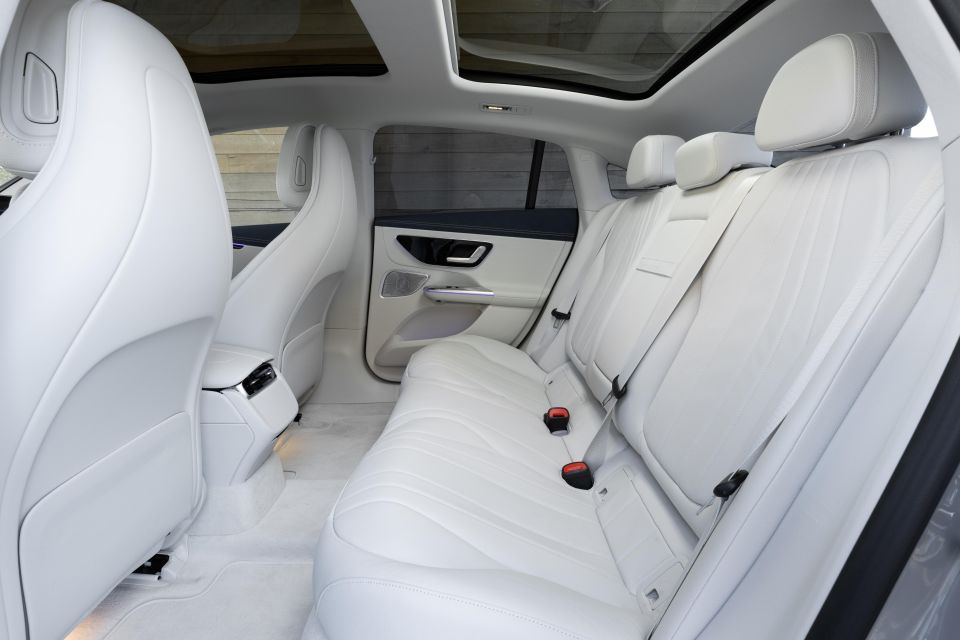
However, legroom and knee room are ample, and the EQE lacks a large driveline hump. Instead, there’s an almost completely flat floor.
There’s a fold-down centre armrest with integrated cupholders, while below the air vents on the centre console you’ll find a little hatch behind which sit two USB-C outlets.
The EQE’s cabin is flashy, but it won’t alienate existing Mercedes-Benz buyers.
The interface of the MBUX infotainment system, the layout of the digital instrument cluster, and key touchpoints like the steering wheel will all look very familiar.
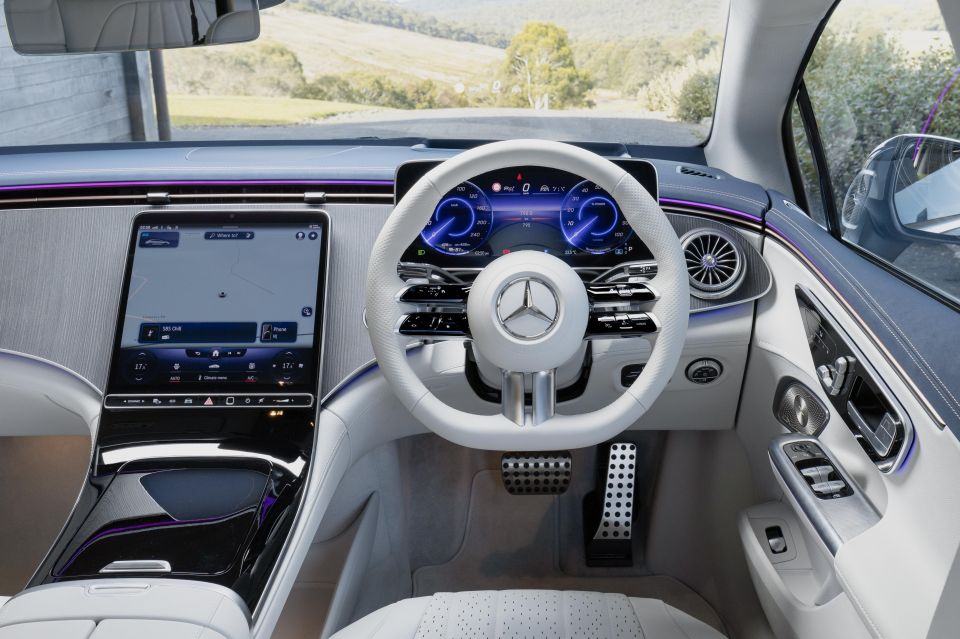
In typical modern Mercedes fashion, the EQE is replete with attractive surfaces and Macau casino-like ambient lighting.
Material quality is generally good, though perhaps not quite as plush as one might expect for the price.
For example, hard plastic trim is used for the lower reaches of the doors, while the soft-touch trim on the sides of the centre console isn’t overly squidgy.
There are some interesting trim elements though, like rose gold metal-look accents and trim on the door tops that feels like worn leather.
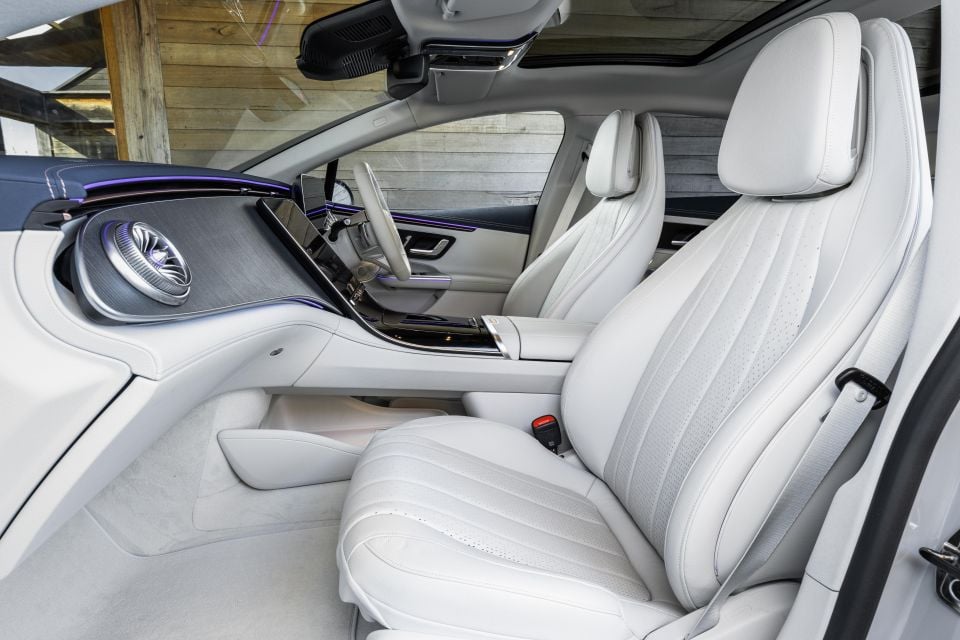
Our tester featured a stunningly impractical interior colourway, comprising a deep Biscay Blue dash top (lovely), white seats and doors (dubious), and white carpets (I beg your pardon?!)
Mercedes-Benz calls the white Neva Grey, but it looks white to me. I’m sure it looks lovely in the showroom, but on a rainy Melbourne day we managed to dirty the carpets almost immediately.
If you buy an EQE in this spec, you and your passengers will have to don those plastic booties police wear at crime scenes.
I’m never usually the type to advocate for a black interior, but in this case it’s the logical choice.
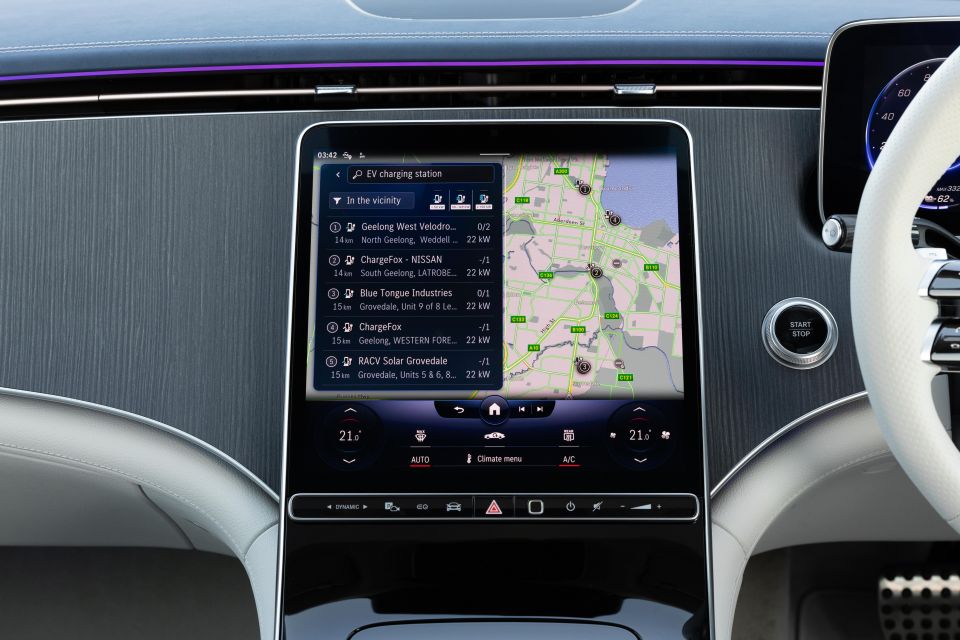
We hope you like wood, because there’s a whole forest of it here, though it does at least provide some welcome contrast in models with the black interior.
The EQE 300 and EQE 350 offer a choice of two different striated wood trims: ship’s deck open-pore walnut wood, and anthracite linestructure lime wood.
We only saw the latter, so we can’t tell you if Mercedes’ interior designers should be forced to walk the plank for the former.
There’s still a sea of gloss black trim, however, on the centre console. A large lid finished in the material conceals the cupholders, two USB-C outlets, and a wireless charging pad.
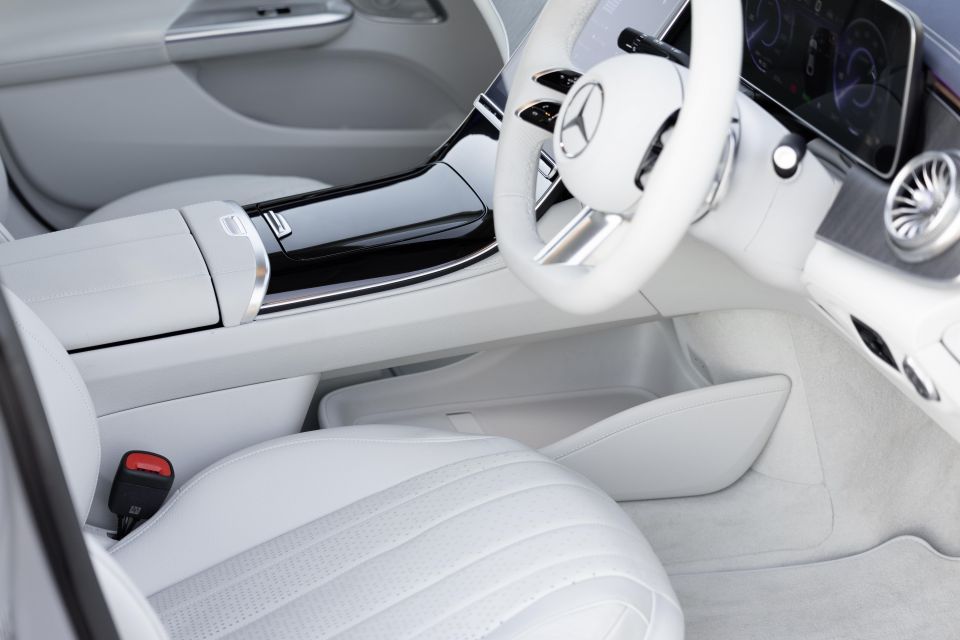
There’s more storage underneath the bridge-like centre console, with an additional two USB-C outlets and a shelf large enough to accommodate a handbag. The centre console bin is also quite deep, so storage up front is top notch.
The shape of the wood inlays on the dash shows just how much real estate the MBUX Hyperscreen takes up, as it fills this space (optionally) in the AMG EQE 53.
Not that you would ever need such an obscenely large screen, as the standard portrait-oriented 12.8-inch screen is enormous.
While there are no physical climate controls, there are digital ones that always appear at the lower regions of the screen.
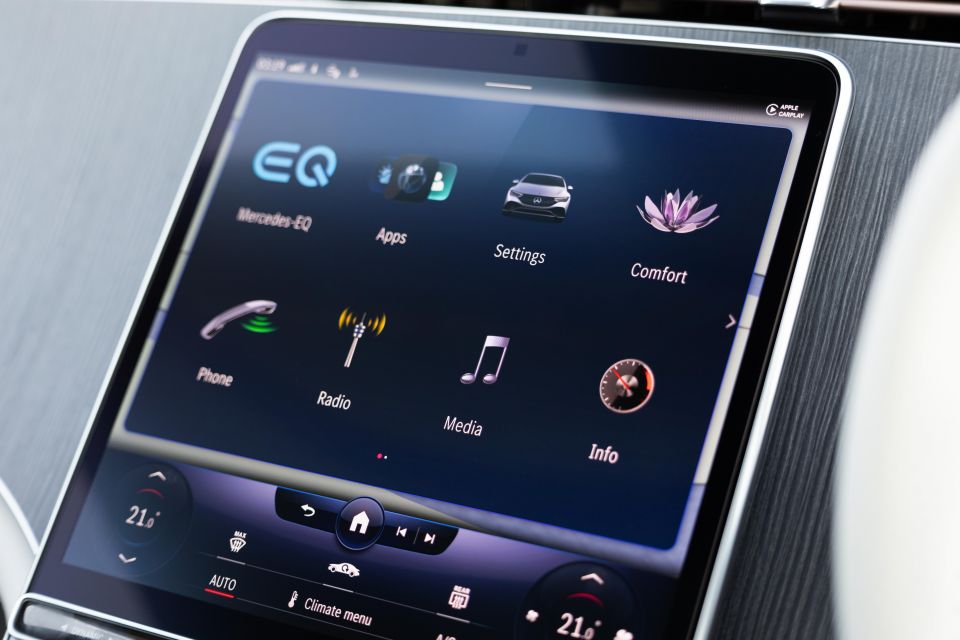
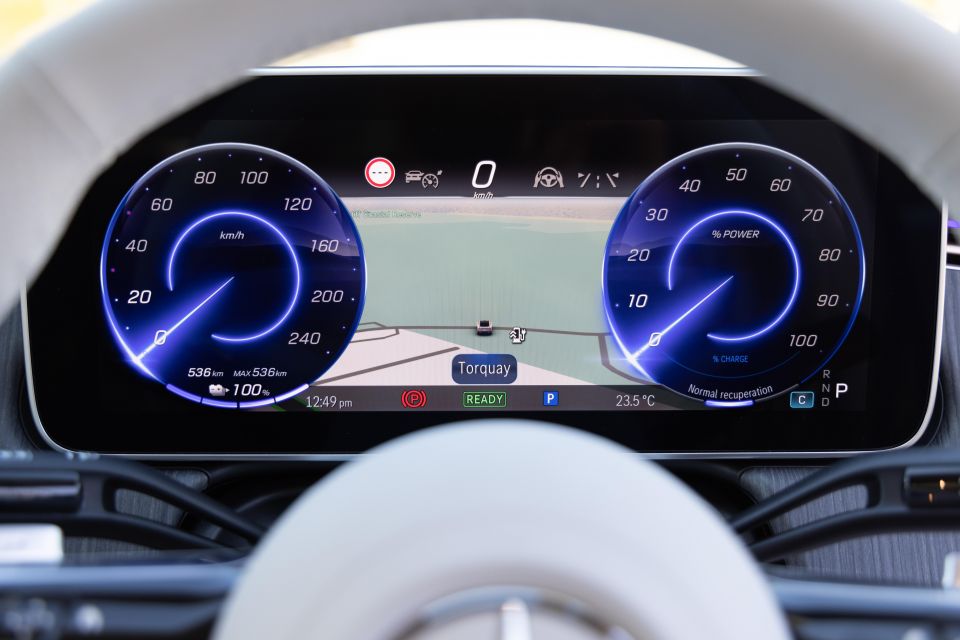
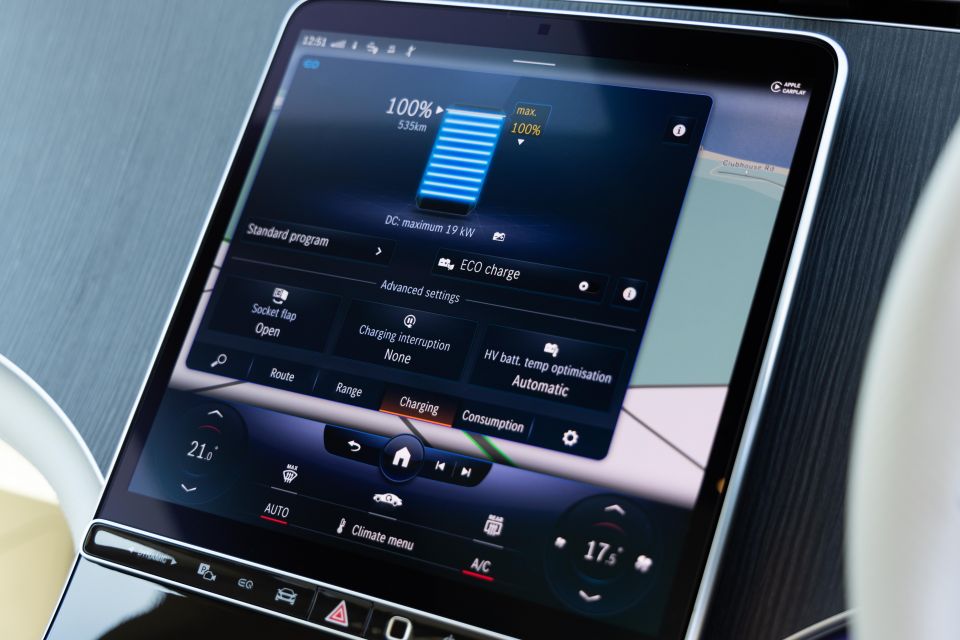
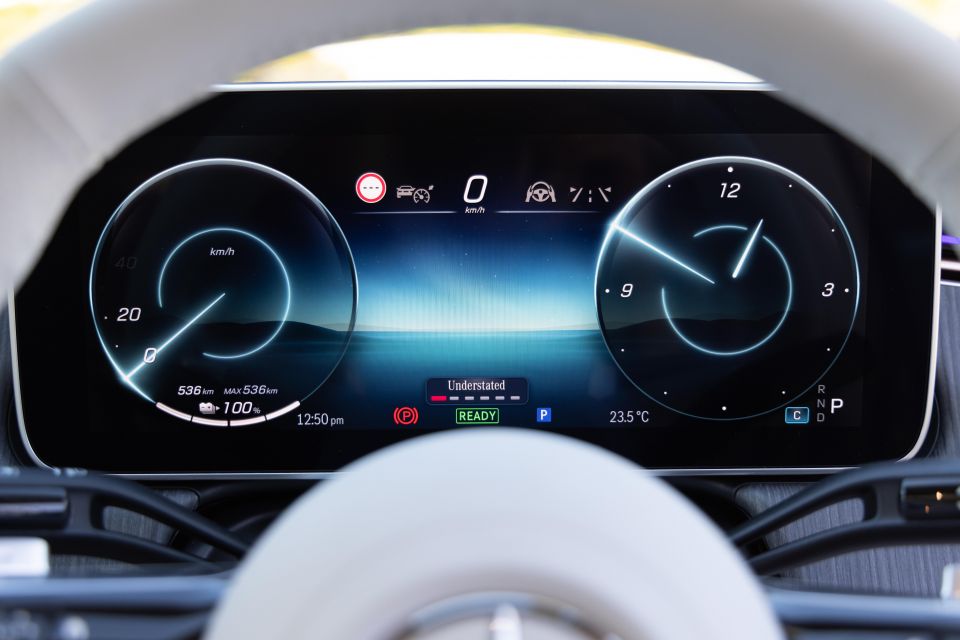
The interface boasts clean, crisp graphics and a fairly intuitive menu structure, while there is a voice assistant available for key functions – though it didn’t always understand us.
The digital instrument cluster offers different themes, easily selectable using the steering wheel. Among these is one that features a map taking up essentially the entire screen. It’s a slick setup.
The seats are comfortable, but there’s no ventilation unless you step up to the AMG.
Mercedes-Benz’s awesome massaging function isn’t available, though there is a “kinetic” function that occasionally moves the seat ever so slightly.
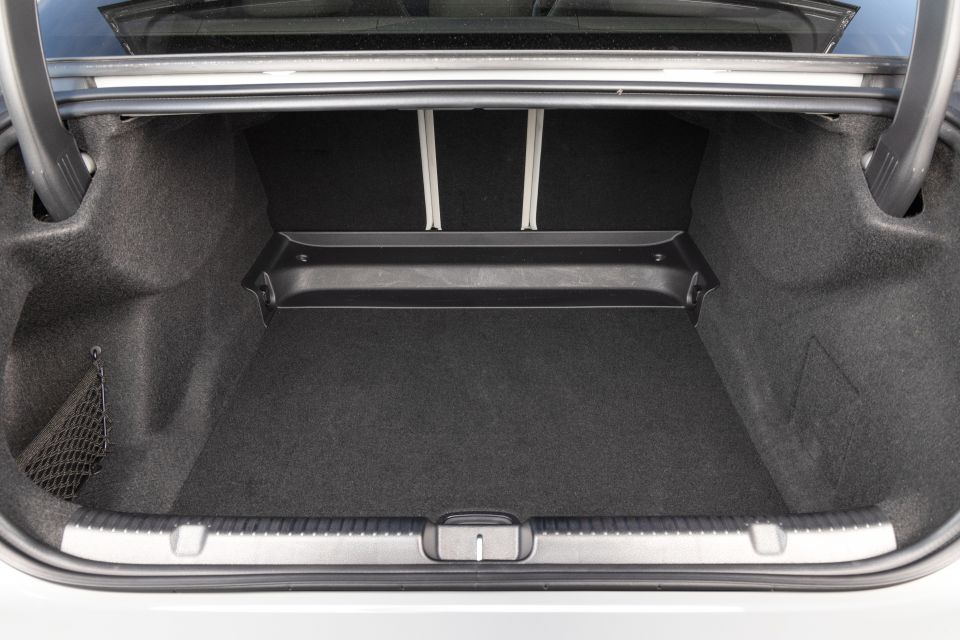
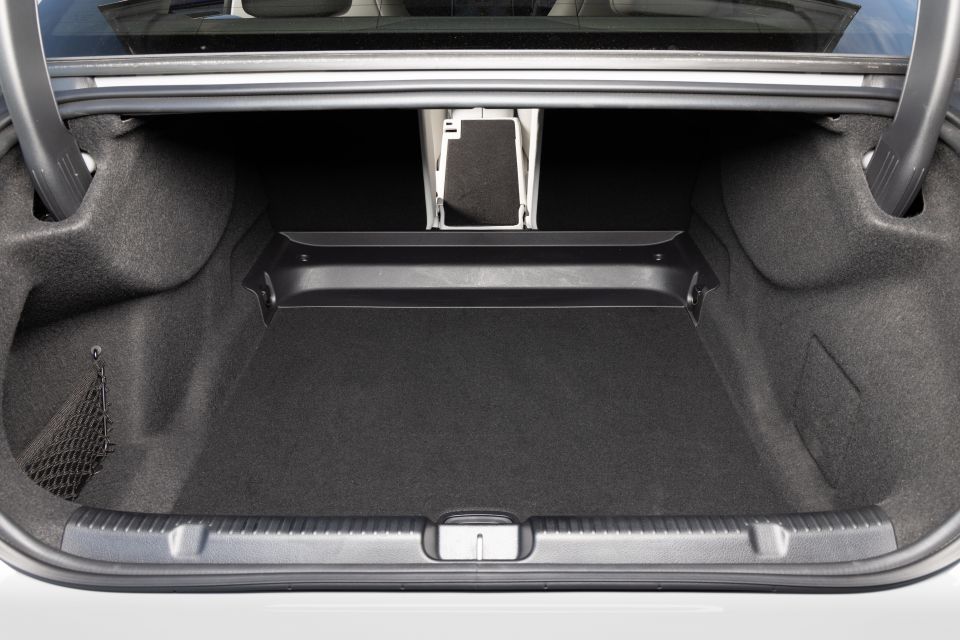
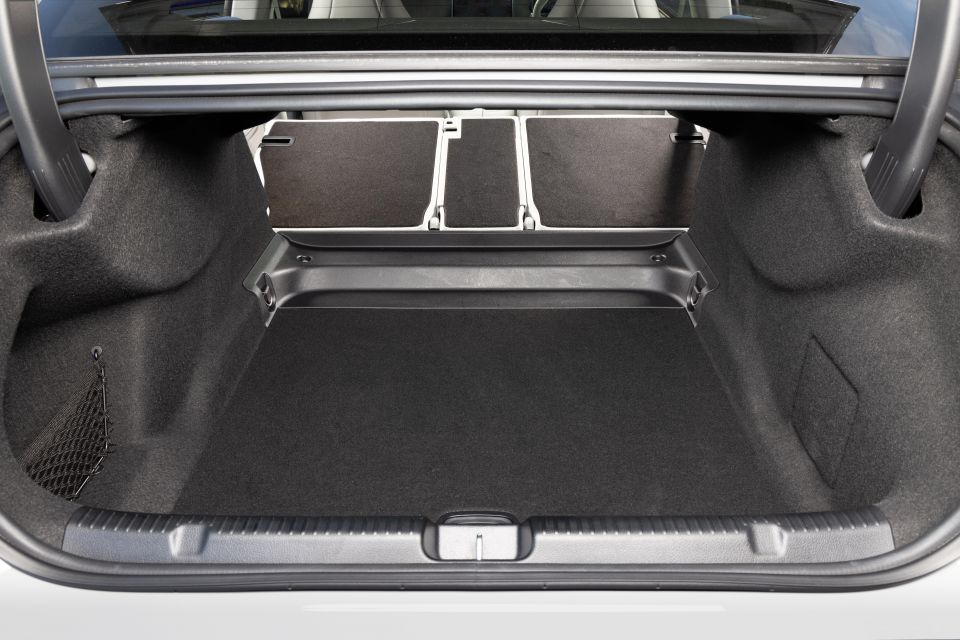
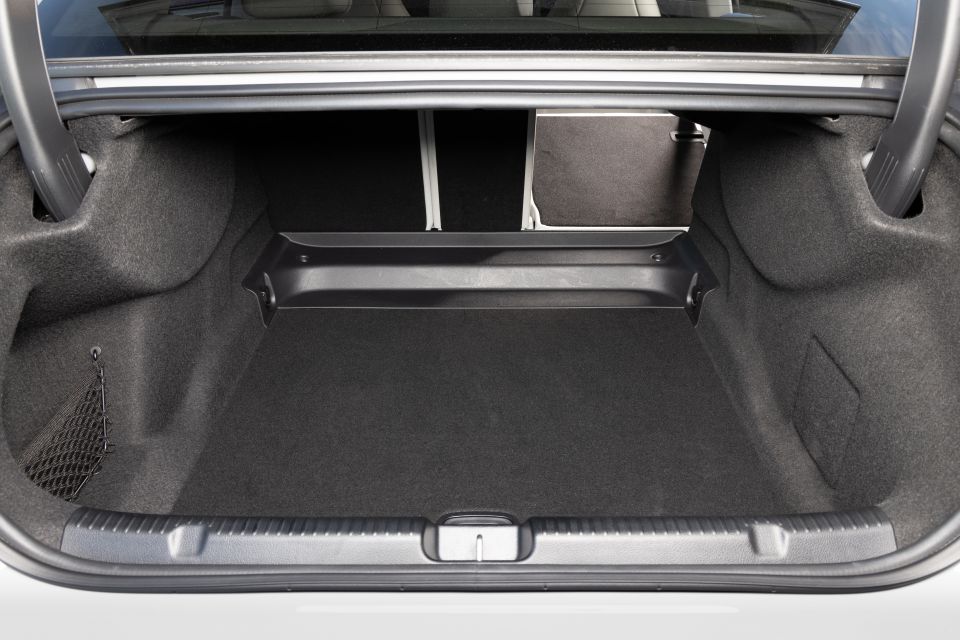
The boot has 430L of luggage space, and you can expand this by folding the rear seats.
However, there’s no front storage cavity like in a Tesla, with Mercedes-Benz instead sealing the bonnet.
The EQE 300 uses a single, rear-mounted electric motor producing 180kW of power and 550Nm of torque, good for a 0-100km/h time of 7.3 seconds. It uses an 89kWh lithium-ion battery.
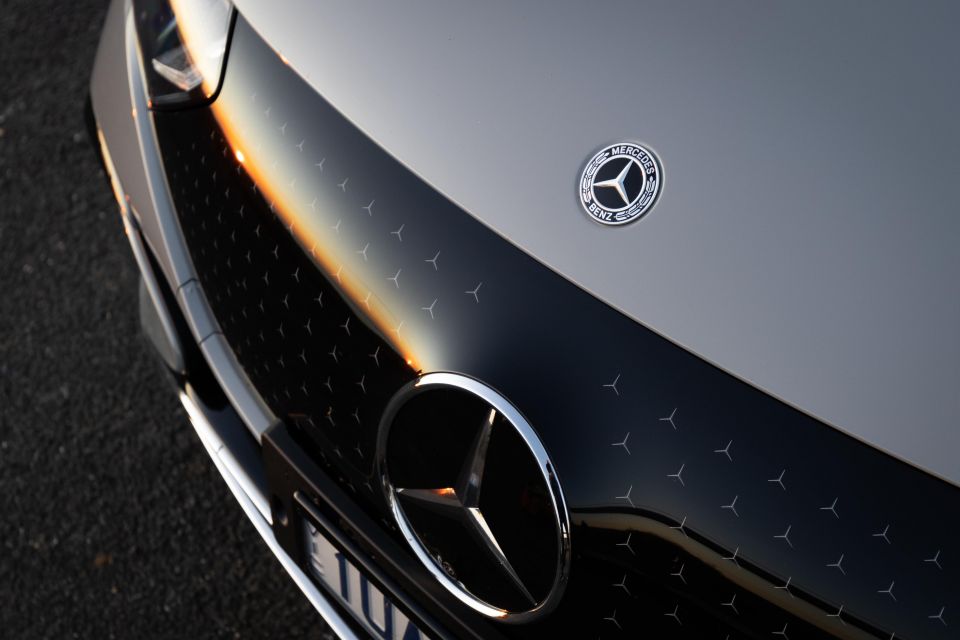
Where expert car reviews meet expert car buying – CarExpert gives you trusted advice, personalised service and real savings on your next new car.
The EQE 350 adds a second electric motor up front for dual-motor all-wheel drive. Its outputs are increased commensurately, with 215kW and 765Nm on tap and a quicker 6.3-second sprint to 100km/h. It uses a 90.5kWh battery.
Mercedes-Benz quotes WLTP range and energy consumption of 508km and 20.1kWh/100km respectively in the EQE 300, and 462km and 22.5kWh/100km in the EQE 350.
That’s good for a large, heavy sedan, though still not quite at Tesla Model S levels despite that model’s advanced age. The American liftback has WLTP energy consumption of between 19 and 19.3kWh/100km, and range of 600-634km, respectively. There’s another key difference here, though: the Tesla remains off-sale in Australia, at least for the time being.
Perhaps a more relevant comparison is the Genesis Electrified G80. It differs from the EQE and Model S in using a combustion-vehicle platform, and yet it still manages to use only 19.1kWh/100km while offering 520km of range.
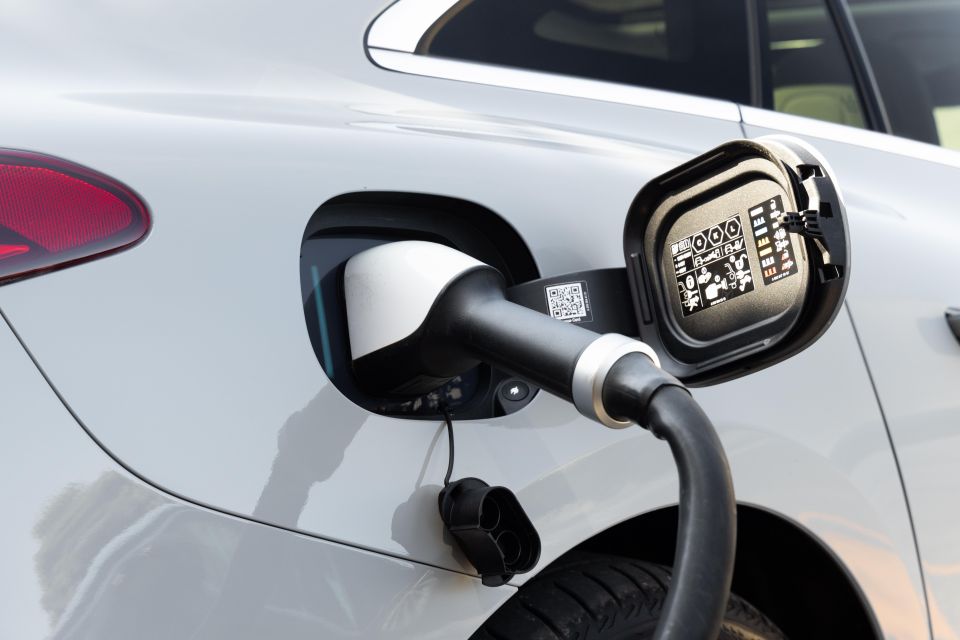
Our drive loops in the EQE 300 and EQE 350 took us through the scenic hills east of Melbourne, as well as some less scenic freeways. We saw overall energy consumption of 22.2kWh/100km in the EQE 300 and 21.1kWh/100km in the EQE 350.
The EQE can be charged at up to 170kW using a DC charger, and 11kW using an AC charger. 22kW AC charging capability is optional.
Mercedes-Benz says the battery can either be fully recycled by Ecobatt or remanufactured by Mercedes-Benz Energy.
The EQE 300 and EQE 350 look almost identical, and they don’t feel especially different to drive either.
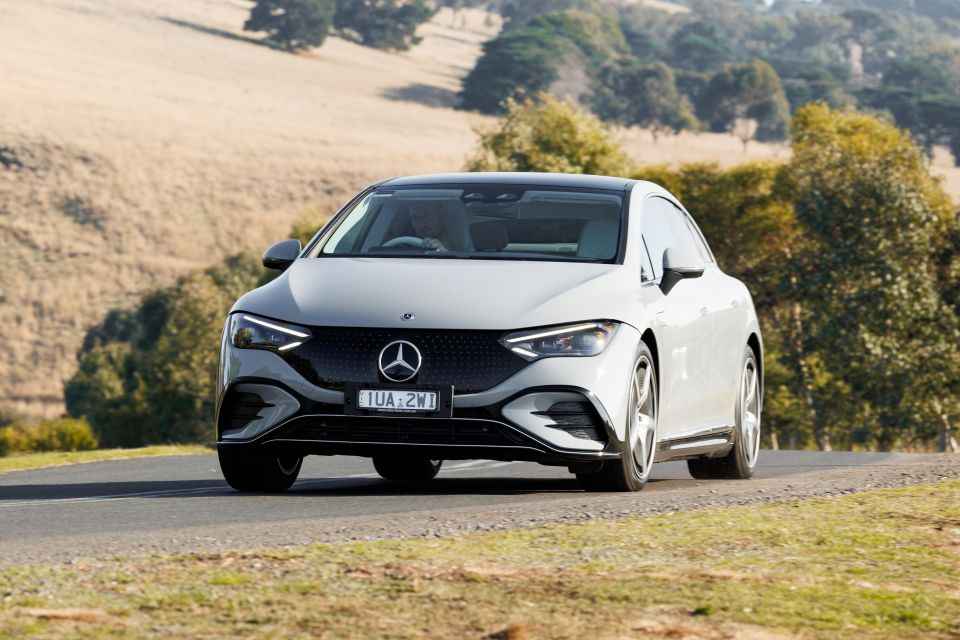
The latter may add all-wheel drive, but the base car is hardly lacking for grip, nor is it lacking for power. The more powerful dual-motor version does shave off a second from the 0-100km/h sprint, but you’d be hard-pressed to notice the difference.
Neither will shove you back in your seat like a Tesla in Ludicrous Mode or, indeed an AMG EQE 53 in Sport+ mode, however both feel responsive with the typical instantaneous torque of an EV.
Ride quality in both the EQE300 and EQE350 is generally good, though the optional Airmatic adaptive air suspension seems a no-brainer for $3800 more. The vehicles we tested, however, featured the passive set-up.
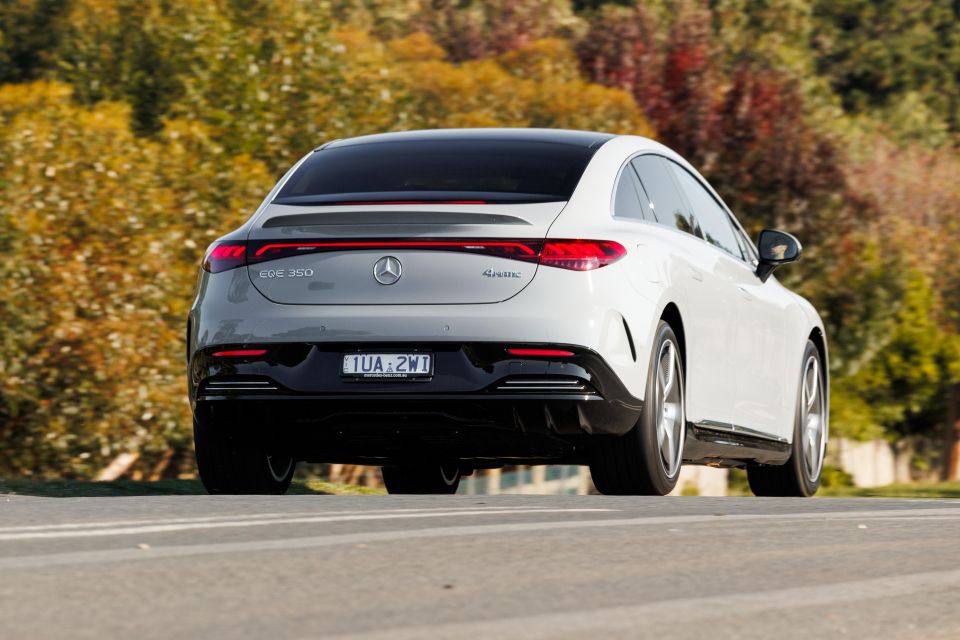
While the EQE doesn’t feel overly harsh for the most part, it will occasionally be upset by mid-corner bumps, which will send a crash through the structure and result in some lateral movement.
The EQE didn’t feel overly floaty on the winding roads we took it on east of Melbourne, and body control feels better than in the AMG model with its air suspension set to Comfort.
It stays nice and hunkered down in corners, though there’s no getting around the fact this is a large, heavy vehicle. It’s poised, but we wouldn’t call it nimble.
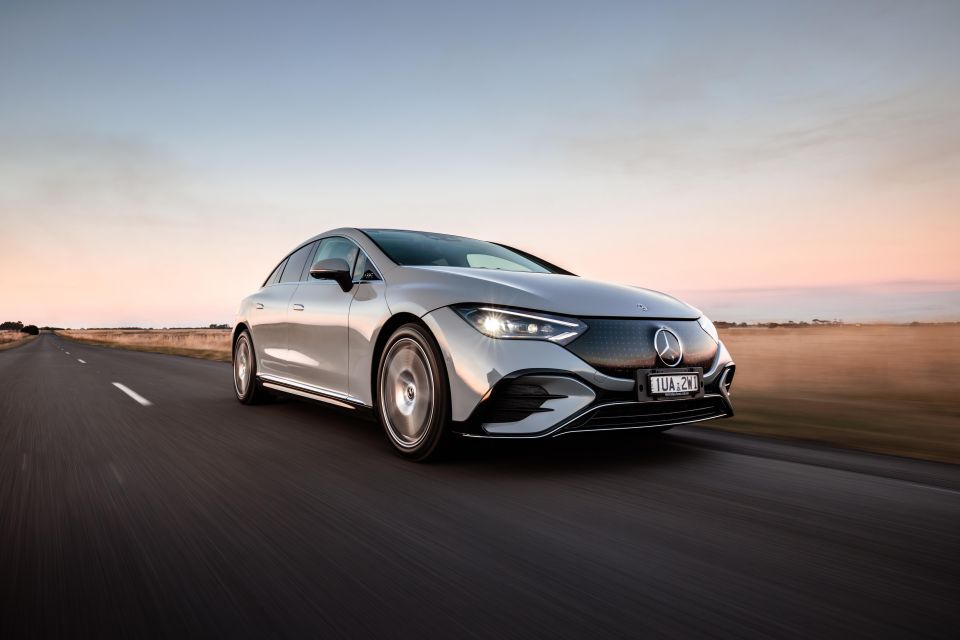
The steering isn’t abundant with road feel, but it’s nicely weighted. You grip a chunky wheel, too. The brake pedal feels a little spongy, however.
The cabin is hushed, even at highway speeds. The EQE cuts through the air without creating any unseemly wind noise, and tyre and other road noise is quelled.
There are three different artificial powertrain sounds: Silver Waves, Vivid Flux and Roaring Pulse. None are actually objectionable, though if they’re not to your taste you can just turn them off; Roaring Pulse has a low, sporty sound which I personally enjoyed.
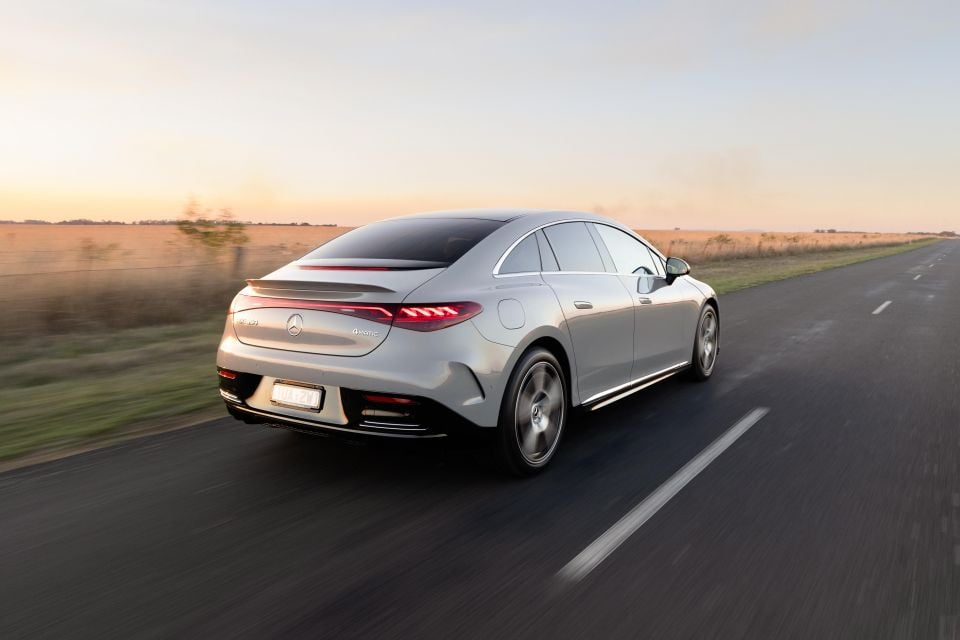
You can adjust the level of regenerative braking via the paddle shifters behind the steering wheel, and there are three levels available.
Powertrain aside, the EQE350 differs from the EQE300 only in offering a rear lip spoiler.
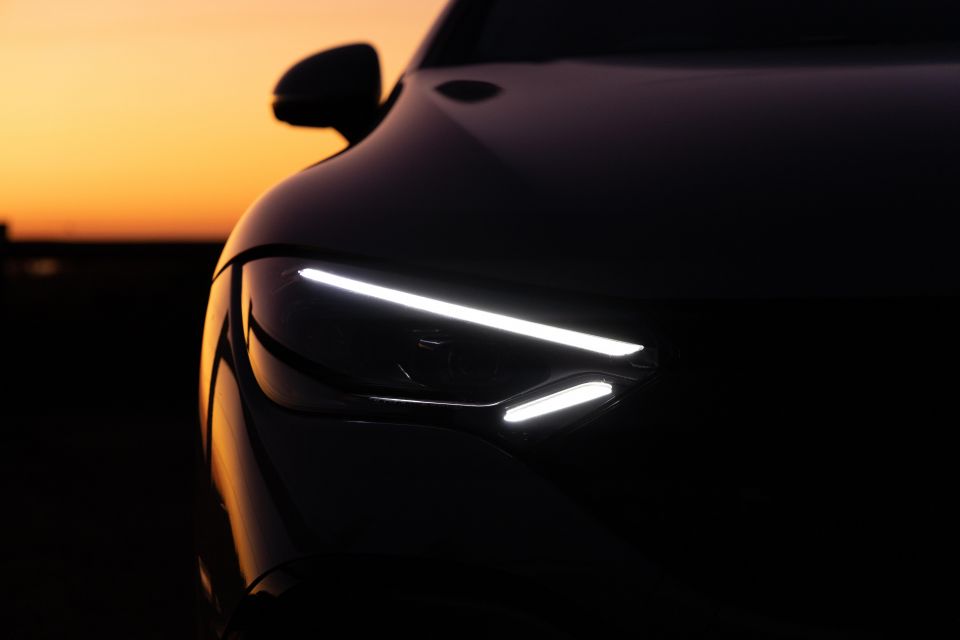
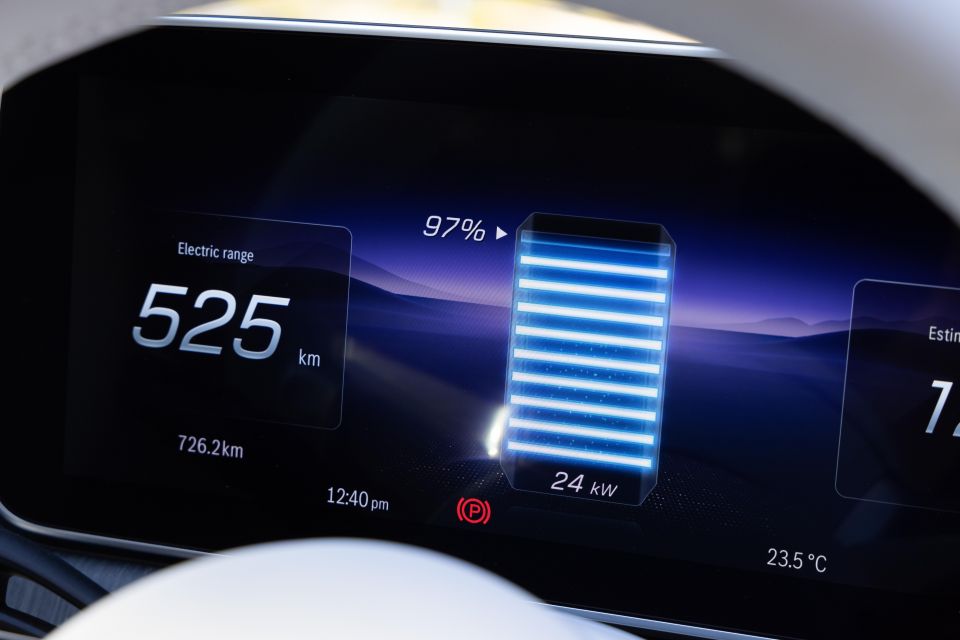

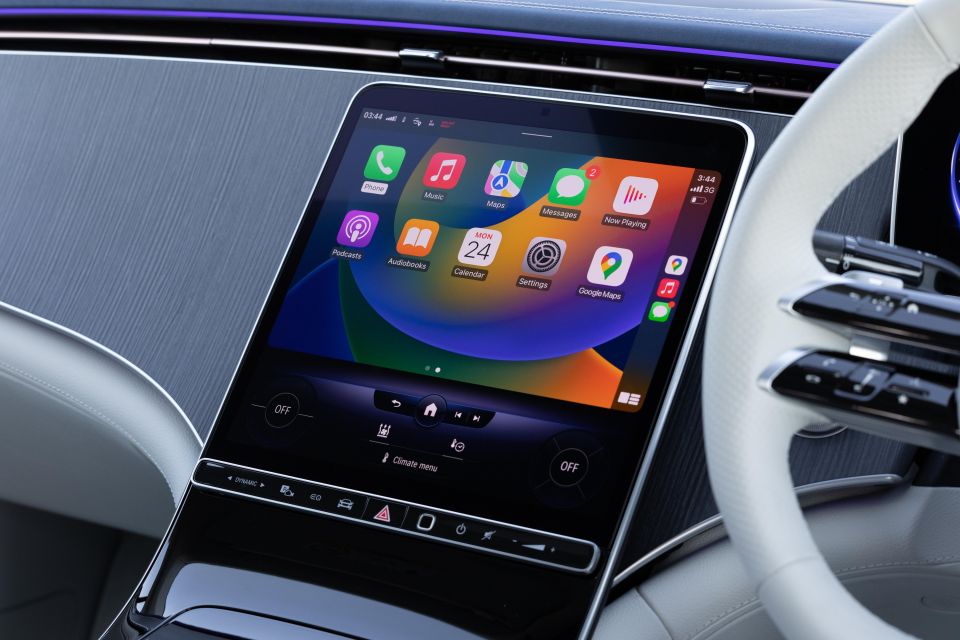
Standard equipment highlights:
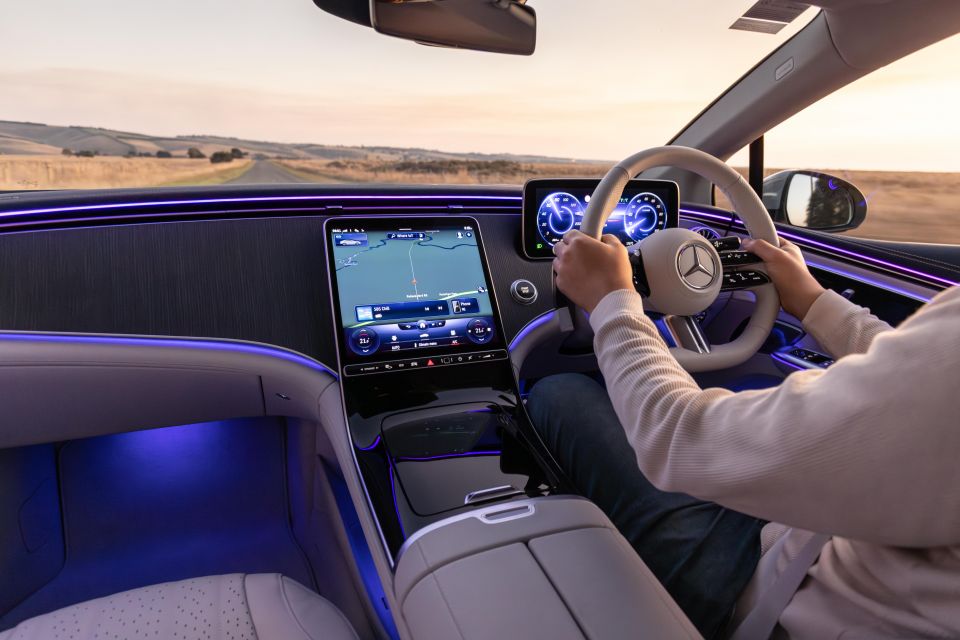
Airmatic adaptive air suspension is a $3800 option, while the following options are also available:
If you want to upgrade the AC charging rate to 22kW, that’ll cost an extra $1800. Mercedes-Benz also says its new Wallbox 2.0 will be available mid-year, priced at $2475.
Metallic paint finishes are all no-cost options, unless you opt for Manufaktur ones. These are priced at $2200.
The Mercedes-Benz EQE has a five-star ANCAP rating, based on Euro NCAP testing conducted in 2022.
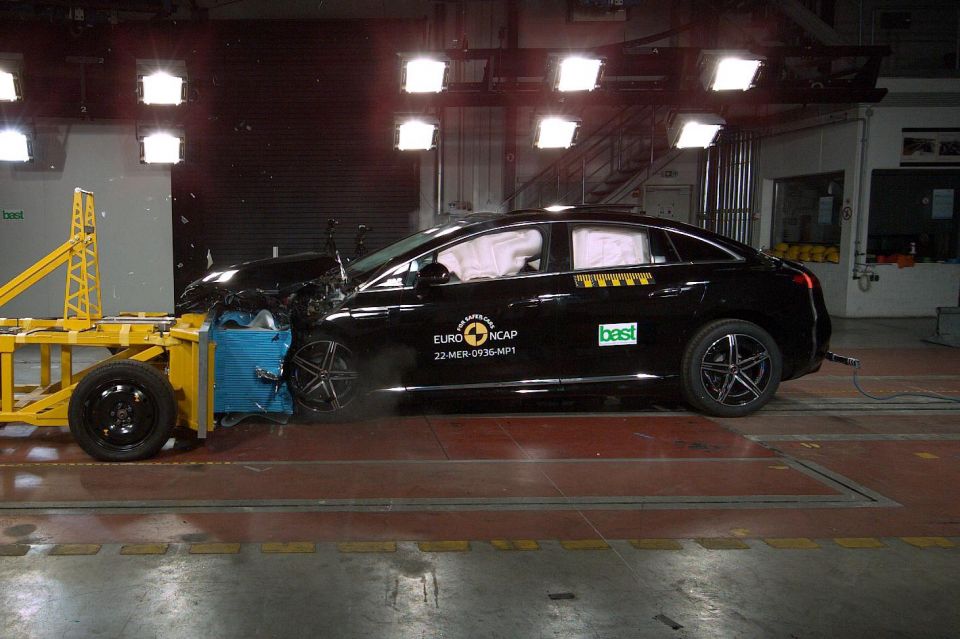
That was based on an adult occupant protection score of 95 per cent, a child occupant protection score of 92 per cent, a vulnerable road user protection score of 83 per cent, and a safety assist score of 82 per cent.
Standard safety equipment includes:
The EQE is backed by a five-year, unlimited-kilometre warranty – the high-voltage battery is also covered by a 10-year, 250,000km warranty.

Servicing is required every 12 months or 15,000km, whichever comes first.
Three-, four- and five-year pre-paid servicing plans are available, priced at $1700, $2500 and $2950, respectively.
Those figures are $1200, $1400 and $2800 lower than an E-Class sedan, though Genesis has the Benz beat with five years of free servicing and a free concierge service if you live within 70km of the Brisbane, Melbourne or Sydney CBDs.
Buy your new car without the stress. It's fast, simple and completely free.

Great service from Travis and team, second time I have used this business would not hesitate to recommend them to anyone
Craig C.
Purchased a Ford Ranger in Sunshine Coast, QLD
CarExpert helped Craig save $7,224 on his Ford Ranger, now let us save you on your next new car.
Get your BEST priceThe EQE is a mix of both the other-worldly – with its exterior styling and available white interior – and the familiar, with its Mercedes-Benz family interfaces.
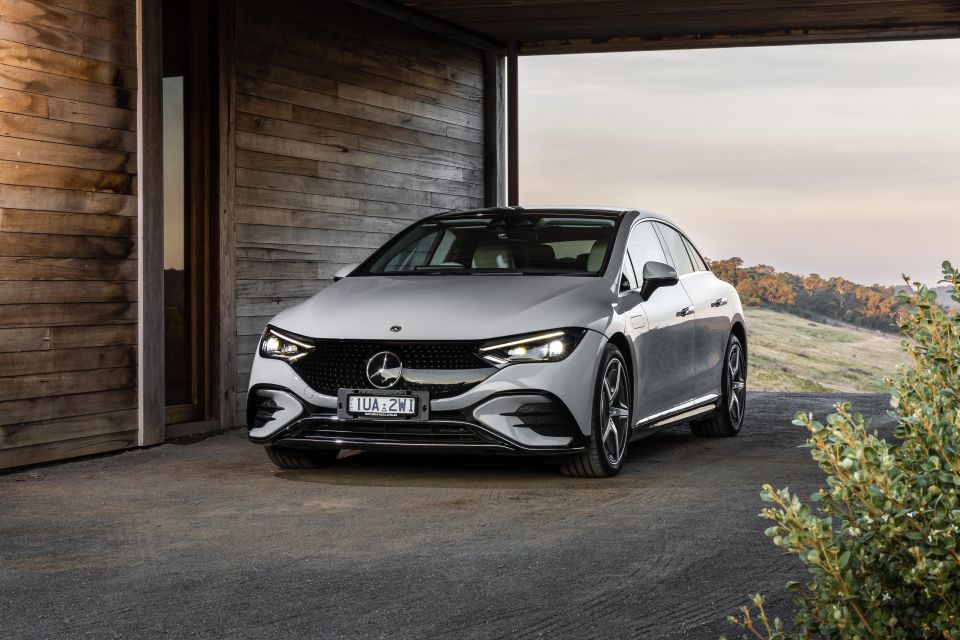
It shouldn’t prove too confronting to drive for those migrating from other Benzes like the E-Class, with smooth power delivery, balanced handling, a generally comfortable ride, and the option of an artificial soundtrack if you find silence deafening.
It comes at a pretty substantial premium over the E-Class, though we don’t have pricing for the next-generation model yet and that gulf could narrow.
For those of you coming from other electric vehicles, you can enjoy some of the key elements you’ve probably gotten quite used to, like a flat rear floor and adjustable regenerative braking. Pity there’s no under-bonnet storage up front.
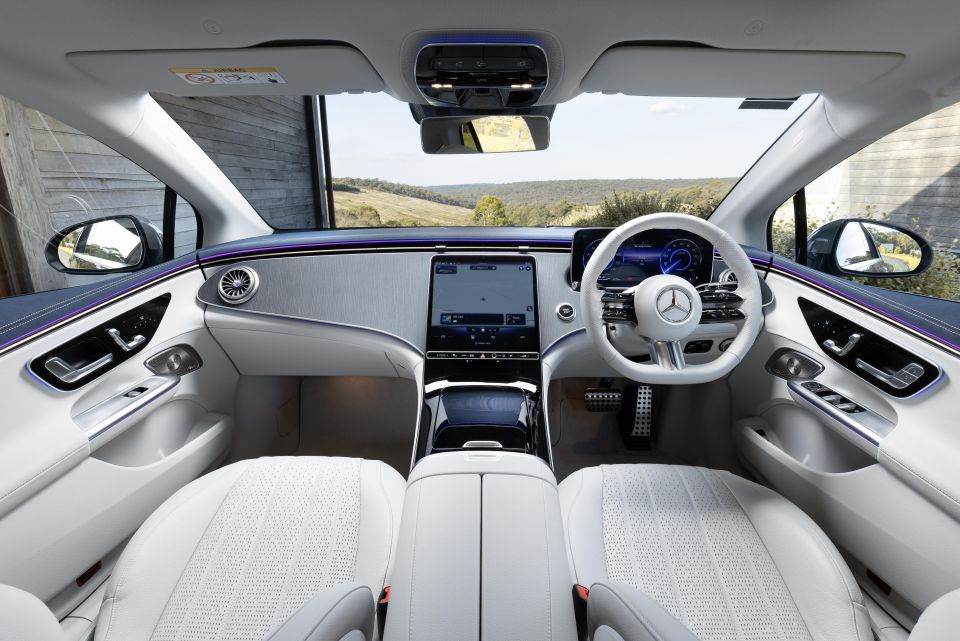
The EQE has entered the Australian market at a time when this segment is experiencing a bit of a lull: Audi and BMW don’t have their models ready yet, and Tesla’s has gone off-sale.
And yet despite its combustion-vehicle roots, the rival Genesis Electrified G80 manages to offer more range, lower energy consumption, and more conventional (if still distinctive) styling, plus the bonus of free servicing.
Mercedes-Benz benefits from a wider dealership network, even if like its upstart rival its prices are fixed now. And for some people, there’s no substitute for the three-pointed star.
For our money, we’d take the base rear-wheel drive EQE 300 and tick the option box for air suspension to get the line-up’s best mix of value, ride comfort, and efficiency.
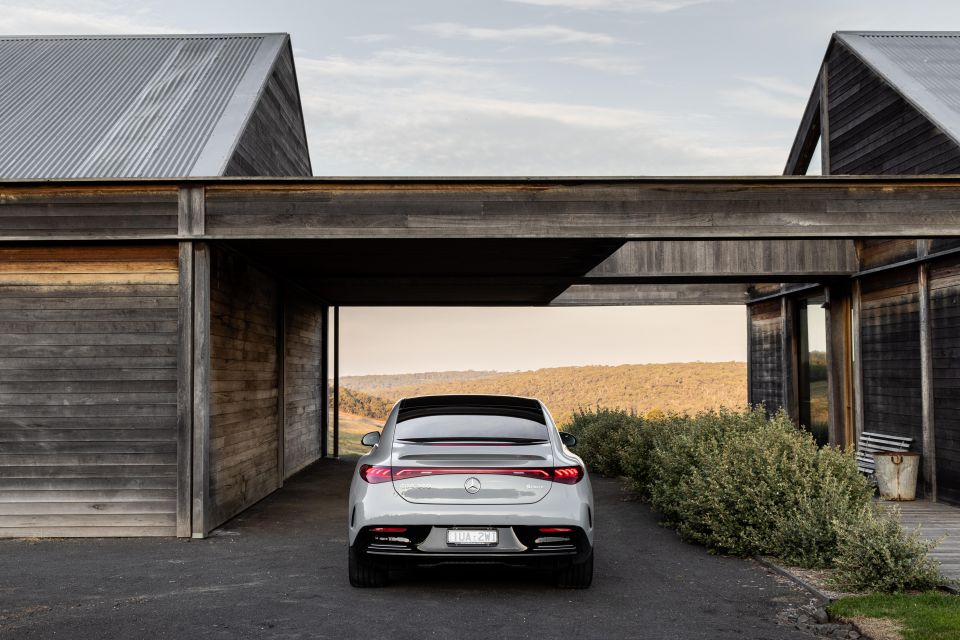
Click the images for the full gallery
Where expert car reviews meet expert car buying – CarExpert gives you trusted advice, personalised service and real savings on your next new car.
William Stopford is an automotive journalist based in Brisbane, Australia. William is a Business/Journalism graduate from the Queensland University of Technology who loves to travel, briefly lived in the US, and has a particular interest in the American car industry.


James Wong
5 Days Ago


James Wong
5 Days Ago
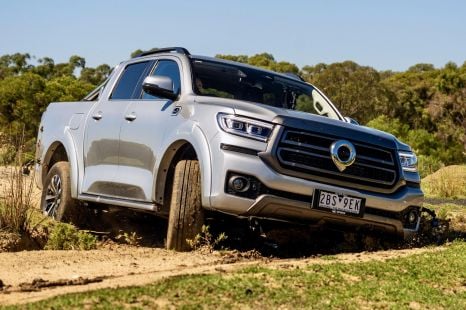

Max Davies
4 Days Ago
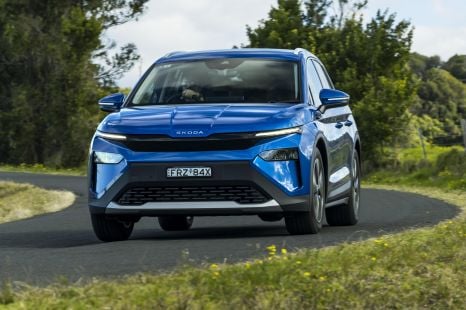

Josh Nevett
2 Days Ago
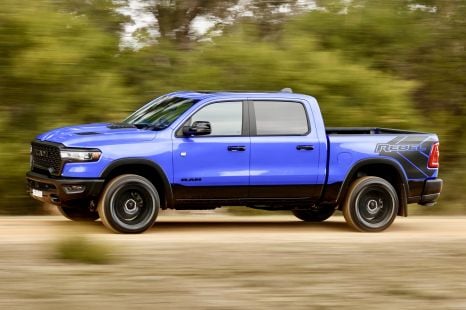

Max Davies
2 Days Ago
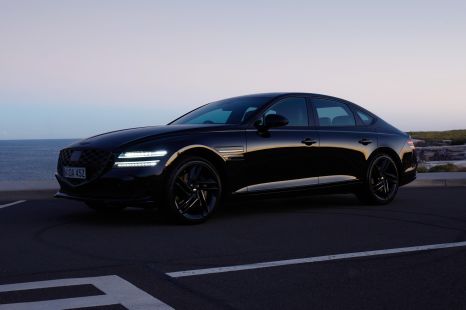

William Stopford
22 Hours Ago